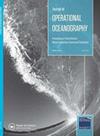利用海洋颜色和卫星衍生的表面流量估算跟踪多云地区渔场参数:孟加拉湾的一项研究
IF 2.4
3区 地球科学
Q4 METEOROLOGY & ATMOSPHERIC SCIENCES
引用次数: 15
摘要
基于不同卫星的海洋生物物理观测,提出了一个新的概念框架,用于跟踪孟加拉湾渔场参数,以确定潜在渔区(PFZ)。该技术还尝试提供基于特征传播的短期预测,即使在多云条件下也是如此。目前开展的研究旨在了解可能的渔获量与卫星衍生参数(如叶绿素浓度、海面温度、海平面异常、海流和风矢量)之间的联系。相对于锋面方向,由风的前后分量获得的净Ekman输运为预报PFZ区域及其可能的转移提供了有价值的信息。将已确定的pfz与有限的原位渔获数据进行比较,证明所建议的方法有望改善对可能的渔获地点的监测。该研究提供了一种利用天基平台上所有可能的海洋信息监测和短期预报PFZ的新方法,即使是云污染地区。本文章由计算机程序翻译,如有差异,请以英文原文为准。
Tracking fishing ground parameters in cloudy region using ocean colour and satellite-derived surface flow estimates: A study in the Bay of Bengal
ABSTRACT A new conceptual framework, based on ocean bio-physical observations from different satellites, has been proposed to track fishing ground parameters to identify Potential Fishing Zones (PFZ) in the Bay of Bengal (BoB). The proposed technique also attempts to provide a short-term forecast based on feature propagation, even under cloudy conditions. The current study has been carried out to understand the link between possible fish catch availability and satellite-derived parameters such as chlorophyll concentration, sea surface temperature, sea-level anomaly, ocean surface currents and wind vectors. Net Ekman transport obtained from the upfront and downfront components of the wind relative to the frontal direction provides valuable information on the forecast of PFZ regions and its possible shift. Comparison of the identified PFZs with limited in situ fish catch data proves that the suggested approach holds the promise in improved monitoring of possible fish catch locations. The study provides a novel approach for the monitoring and short-term forecasting of PFZ even for cloud-contaminated regions by using all possible ocean information from space-based platforms.
求助全文
通过发布文献求助,成功后即可免费获取论文全文。
去求助
来源期刊
CiteScore
7.50
自引率
9.70%
发文量
8
审稿时长
>12 weeks
期刊介绍:
The Journal of Operational Oceanography will publish papers which examine the role of oceanography in contributing to the fields of: Numerical Weather Prediction; Development of Climatologies; Implications of Ocean Change; Ocean and Climate Forecasting; Ocean Observing Technologies; Eutrophication; Climate Assessment; Shoreline Change; Marine and Sea State Prediction; Model Development and Validation; Coastal Flooding; Reducing Public Health Risks; Short-Range Ocean Forecasting; Forces on Structures; Ocean Policy; Protecting and Restoring Ecosystem health; Controlling and Mitigating Natural Hazards; Safe and Efficient Marine Operations

 求助内容:
求助内容: 应助结果提醒方式:
应助结果提醒方式:


